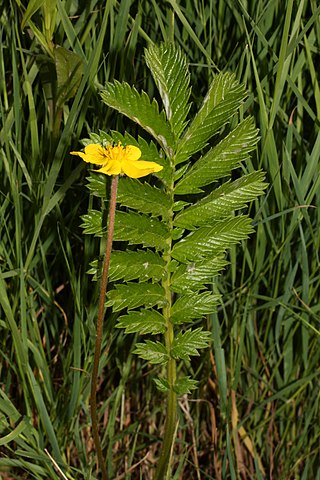
Argentina anserina is a perennial flowering plant in the rose family, Rosaceae. It is known by the common names silverweed, common silverweed or silver cinquefoil. It is native throughout the temperate Northern Hemisphere, often on river shores and in grassy habitats such as meadows and road-sides. The plant was originally placed in the genus Potentilla by Carl Linnaeus in his Species plantarum, edition 1, (1753) but was reclassified into the resurrected genus Argentina by research conducted in the 1990s. The reclassification remains controversial and is not accepted by some authorities. It is a species aggregate which has frequently been divided into multiple species.

Dasiphora fruticosa is a species of hardy deciduous flowering shrub in the family Rosaceae, native to the cool temperate and subarctic regions of the northern hemisphere, often growing at high altitudes in mountains. Dasiphora fruticosa is still widely referenced in the horticultural literature under its synonym Potentilla fruticosa. Common names include shrubby cinquefoil, golden hardhack, bush cinquefoil, shrubby five-finger, widdy, kuril tea and tundra rose.

Potentilla indica, known commonly as mock strawberry, Indian-strawberry, or false strawberry, often referred to as a backyard strawberry, mainly in North America, is a flowering plant in the family Rosaceae. It has foliage and an aggregate accessory fruit similar to that of a true strawberry. It has yellow flowers, unlike the white or slightly pink flowers of true strawberries. It is native to eastern and southern Asia, but has been introduced to many other areas as a medicinal and an ornamental plant, subsequently naturalizing in many regions worldwide. It is considered invasive in some regions of the United States.

Drymocallis arguta, commonly known as the tall cinquefoil, prairie cinquefoil, or sticky cinquefoil, is a perennial herbaceous plant native to North America. It was formerly included with the typical cinquefoils in the genus Potentilla.

Potentilla gracilis, known as slender cinquefoil or graceful cinquefoil, is a species of cinquefoil. It ranges from Alaska down the west coast of Canada and the United States, and Colorado.

Potentilla californica, also known as California horkelia, is a species of flowering plant in the rose family.
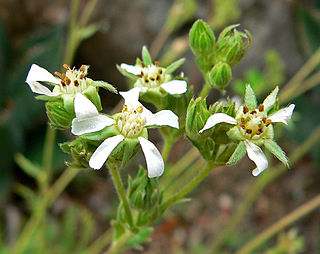
Potentilla clevelandii, also known as Cleveland's horkelia, is a species of flowering plant in the rose family. It is native to the Peninsular Ranges of southern California and northern Baja California.

Potentilla daucifolia, commonly known as carrotleaf horkelia, is a species of flowering plant in the rose family. It is native to the Klamath Mountains and surrounding ranges in northern California and southern Oregon. It grows on mountain slopes and fields, often on serpentine soils.
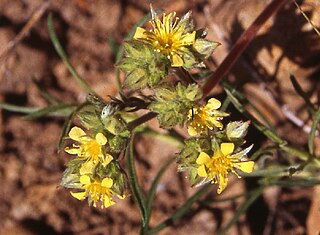
Potentilla aperta, commonly known as Sierra Valley mousetail, is a species of flowering plant in the rose family.
Potentilla argyrocoma, commonly known as silverhair mousetail, is a species of flowering plant in the rose family. It is native to the San Bernardino Mountains of southwestern San Bernardino County, California. A population of Potentilla argyrocoma is also found in Baja California in Mexico; this population may or may not be distinct and further study is required.
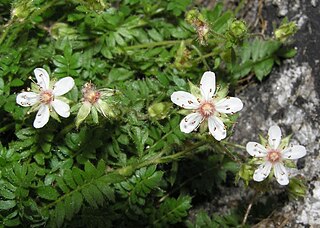
Potentilla callida, commonly known as Tahquitz mousetail, is a rare species of flowering plant in the rose family.

Potentilla jaegeri, also known as Jaeger's mousetail and Jaeger's ivesia, is an uncommon species of flowering plant in the rose family.

Potentilla recta, the sulphur cinquefoil or rough-fruited cinquefoil, is a species of cinquefoil. It is native to Eurasia but it is present in North America as an introduced species, ranging through almost the entire continent except the northernmost part of Canada and Alaska.

Potentilla diversifolia or Potentilla × diversifolia is a species of flowering plant in the Rose Family (Rosaceae) known by the common names varileaf cinquefoil, different-leaved cinquefoil, and mountain meadow cinquefoil.

Potentilla norvegica is a species of cinquefoil known by the common names rough cinquefoil, ternate-leaved cinquefoil, and Norwegian cinquefoil. It is native to Europe, Asia, and parts of North America, and it can be found elsewhere as an introduced species.

Potentilla villosa is a species of flowering plant in the rose family, Rosaceae. Its common names include villous cinquefoil, northern cinquefoil, and hairy cinquefoil. It is native to northwestern North America, where its distribution extends from Alaska to Alberta to Oregon. There are records from eastern Asia.
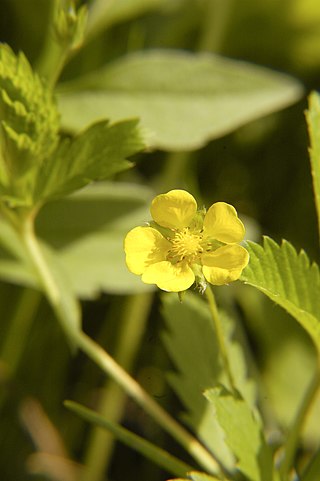
Potentilla simplex, also known as common cinquefoil or old-field five-fingers or oldfield cinquefoil, is a perennial herb in the Rosaceae (rose) family native to eastern North America from Ontario, Quebec, and Labrador south to Texas, Alabama, and panhandle Florida.
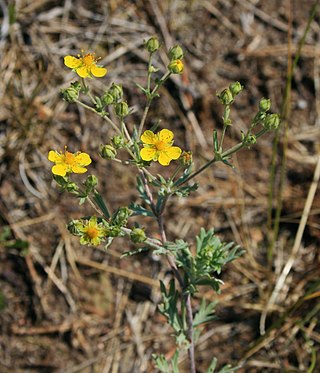
Potentilla argentea, known as hoary cinquefoil, silver cinquefoil, silvery cinquefoil, or silver-leaf cinquefoil, is a perennial herb in the family Rosaceae. Potentilla argentea is native to Europe, Asia Minor, and Siberia, and is introduced throughout temperate areas in North America and in New Zealand.
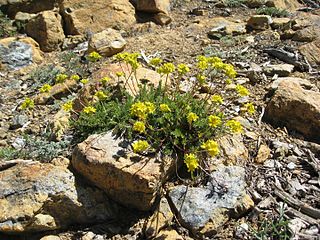
Ivesia tweedyi, Tweedy's mousetail or Tweedy's ivesia, is a perennial herb in the rose family. It is native to the Pacific Northwest in the United States, from Washington east to westernmost Montana.

Drymocallis fissa, the bigflower cinquefoil, also known as the leafy cinquefoil, leafy drymocallis, or wood beauty, is a small plant also sometimes classified as Potentilla fissa. It is a herbaceous plant with a thick taproot known for its moderately hairy leaves, redish leaf stems, and relatively large yellow flowers. It is native to foothills and lower mountains the Rocky Mountain region in the western United States.



















